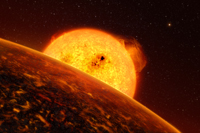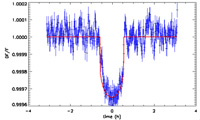Smallest exoplanet is shown to be a solid, rocky world
16 September 2009
The confirmation of the nature of CoRoT-7b as the first rocky planet outside our Solar System marks a significant step forward in the search for Earth-like exoplanets. The detection by CoRoT and follow-up radial velocity measurements with HARPS suggest that this exoplanet, CoRoT-7b, has a density similar to that of Mercury, Venus, Mars and Earth making it only the fifth known terrestrial planet in the Universe.
 |
|
Illustration of CoRoT-7b |
A number of techniques are routinely employed in the search for exoplanets: spectroscopic radial velocity, astrometry, microlensing, photometric transits. Of these, the search for transits - the passage of the exoplanet in front of the parent star - provides unprecedented access to the planet's physical properties. In particular, the combination of transit photometry and radial velocity measurements provides direct and very accurate estimates of the planetary mass and radius, and hence mean density. These parameters in turn provide tight constraints on the composition and physical structure of the planet and hence on the likelihood of the exoplanet being a true Earth analogue.
The CoRoT space mission employs the transit strategy in the search for exoplanets. Continuous observations, lasting about 150 days each, are made of two large (4 square degrees) regions towards the centre and anti-centre of the Galaxy. During the first of these observation periods towards the anti-centre (October 2007 to March 2008), 46 stars exhibited evidence for transits, among them CoRoT-7, a main-sequence, close-by (at a distance of 150 pc) solar-type star.
The size is determined with photometry from CoRoT ...
 |
|
The dip in the light curve revealed the presence of CoRoT-7b |
Further progress, and in particular the determination of the planet mass, could only be made by obtaining accurate measurements of the variation in the velocity of the star caused by the gravitational pull of the orbiting planet. The need for ground-based support observations for CoRoT had always been envisaged and time on the HARPS spectrograph (at the ESO 3.6-m telescope at La Silla in Chile) had been secured as a result of an ESA call for European co-investigators for CoRoT. Didier Queloz and colleagues describe how almost 70 hours of observations of the CoRoT-7 system with HARPS finally provided the sought-after result: CoRoT-7b is one of the lightest exoplanets detected to date with a mass five times that of the Earth. This puts CoRoT-7b firmly in the category of "super-Earth" - an exoplanet with a mass between that of Earth and gas giants.
A terrestrial exoplanet orbiting a solar-type starAlthough about a dozen super-Earths have been detected CoRoT-7b is the first for which both mass and radius estimates are available. Combining the radius estimates from CoRoT and the mass estimates from HARPS results in an exoplanet mean density of 5.5 g/cm3. There are only three other known planets with similar density: Earth, Mercury and Venus (Mars is less dense) which strongly suggests that the planet is a solid, rocky planet.
"We are coming tantalising close to reaching the ultimate goal of detecting a true Earth-like planet," comments Malcolm Fridlund, ESA CoRoT Project Scientist and member of the CoRoT Science Team. "This bodes well for future exoplanet search missions, such as the Cosmic Vision candidate, PLATO."
Related publications
Léger, A., et al., "Transiting exoplanets from the CoRoT space mission VIII. CoRoT-7b: the first Super-Earth with measured radius", to appear in A&A, volume 506-1, October 2009.
Queloz, D., et al., "The CoRoT-7 planetary system: two orbiting Super-Earths", to appear in A&A, volume 506-1, October 2009. DOI: 10.1051/0004-6361/200913096
Editor's note
CoRoT is a mission led by the French national space agency, CNES. ESA has joined the mission by providing the optics and baffle for the telescope and testing of the payload. Through this collaboration a number of European scientists, from Denmark, Switzerland, the United Kingdom and Portugal, have been selected as Co-Investigators in open competition. As a result of ESA's participation in CoRoT, scientists from ESA's Member States have access to the satellite's data.
ESA's Research and Scientific Support department (RSSD) at ESTEC is a full partner in CoRoT by providing the on-board Data Processing Units (DPU's). Other partners in CoRoT are Austria, Spain, Germany, Belgium and Brazil.
The ESA PRODEX programme has supported the development of the CoRoT telescope baffle, and the software development and data processing of CoRoT light curves.
The ground stations used for CoRoT are located in Kiruna (S), Aussaguel (F) Hartebeesthoek (South Africa), Kourou (French Guyana), with mission-specific ground stations in Alcantara (Brazil) and Vienna (A).
Contact
Malcolm Fridlund, ESA CoRoT Project Scientist
Research and Scientific Support Department,
Science and Robotic Exploration Directorate, ESA, The Netherlands.
Email: malcolm.fridlund esa.int
esa.int
Phone: +31 71 5653009

